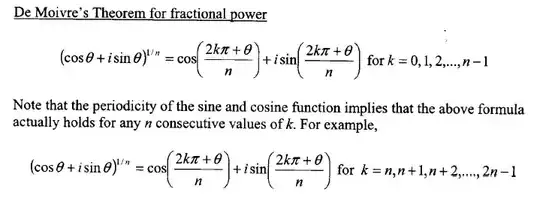This answer is far too long (just copied and pasted from something I did before) --- the crucial point is that $n$ consecutive values of $k$ gives $n$ distinct answers. The fundamental theorem of algebra guarantees that there are no more.
More details here: http://irishjip.wordpress.com/2011/11/19/project-maths-a-more-geometric-approach-to-de-moivres-theorem-and-complex-roots/ --- pictures also.
Proposition
Suppose that $z_1$ has magnitude $r$ and argument $\theta$; and $z_2$ has magnitude $ s$ and argument $\alpha$. Then the product of $z_1$ and $z_2$ has magnitude $r\times s$ and argument $\theta+\alpha$.
Proof : We simply compute:
$$z_1z_2=r(\cos\theta+i\sin\theta)\times s(\cos\alpha+i\sin\alpha),$$
$$=rs(\cos\theta+i\sin\theta)(\cos\alpha+i\sin\alpha),$$
$$=rs(\cos\theta\cos\alpha+i\cos\theta\sin\alpha+i\sin\theta\cos\alpha-\sin\theta\sin\alpha),$$
$$=rs(\cos\theta\cos\alpha-\sin\theta\sin\alpha+i(\cos\theta\sin\alpha+\sin\theta\cos\alpha)).$$
Now note the identities:
$$\cos(A+B)=\cos A\cos B-\sin A\sin B,$$
$$\sin(A+B)=\cos A\sin B+\sin A\cos B.$$
Therefore
$$z_1z_2=rs(\cos(\theta+\alpha)+i\sin(\theta+\alpha)).$$
That is $z_1z_2$ has magnitude $rs$ and argument $\theta+\alpha$ $\bullet$
In other words, we can simplify the multiplication of complex numbers to
$$(r,\theta)\times(s,\alpha)=(rs,\theta+\alpha).$$
A lot more elegant in my opinion than the standard approach!
De Moivre's Theorem
This work makes De Moivre's Theorem very straightforward indeed.
De Moivre's Theorem for Natural Number Powers
Suppose that $z=(r,\theta)$ and $n\in\mathbb{N}$. Then
$$z^n=(r^n,n\theta).$$
Proof : Well, this isn't really necessary --- it really is obvious with the work done above.
$$z^n=\underbrace{z\times z\times\cdots\times z}_{n\text{ times}},$$
$$\Rightarrow z^n=(r\times r\times \cdots\times r,\theta+\theta+\cdots+\theta)=(r^n,n\theta)\,\,\bullet$$
De Moivre's Theorem for Integer Powers
Suppose that $z=(r,\theta)$ and $n\in\mathbb{Z}$. Then
$$z^n=(r^n,n\theta).$$
Proof : The case of $n\geq 1$ is covered by the last theorem. If $n=0$ we need
$$z^0=(r^0,0\theta).$$
But $z^0=1$, $r^0=1$ and $0\theta=0$ so we just have to show
$$1=(1,0),$$
which is true (draw a diagram).
Now suppose $n<0$, say $n=-m$ for $ m\in\mathbb{N}$.
$$z^{n}=z^{-m}=\frac{1}{z^m}=\frac{(1,0)}{(r^m,m\theta)}.$$
We have seen already seen how to do division:
$$\frac{(1,0)}{(r^m,m\theta)}=\left(\frac{1}{r^m},0-m\theta\right)=(r^{-m},-m\theta)=(r^n,n\theta)$$
as required $ \bullet$
Roots of Unity
Recall the set of complex numbers $\{1,i,-1,-i\}$ --- which can be written in polar form $\{(1,0),(1,\pi/2),(1,\pi),(1,3\pi/2)\}$. What happens when we take any of these to the power of four?
$$(1,0)^4=(1^4,4(0))=1,$$
$$(1,\pi/2)^4=(1,4\pi/2)=(1,2\pi)=(1,0)=1,$$
$$(1,\pi)^4=(1,4\pi)=(1,0)=1,$$
$$(1,3\pi/2)^4=(1,4(3\pi/2))=(1,6\pi)=(1,0)=1.$$
So these are all numbers such that when we raise them to the power of four, we get one --- that is they are fourth roots of $1$. A good question at this point is to ask are there any more complex numbers $z=a+ib=(r,\theta)$ such that $z^4=1$? The natural setting for this question is back in the algebra picture --- it is a deep theorem that every complex polynomial has a root. Now we can use the factor theorem:
Factor Theorem
Suppose that $p:\mathbb{C}\rightarrow\mathbb{C}$ is a polynomial. Then $k\in\mathbb{C}$ is a root of $p$ if and only if $(z-k)$ is a factor of $p$.
Proof : Here http://irishjip.wordpress.com/2010/09/08/an-inductive-proof-of-the-factor-theorem/ $\bullet$
The fact that a polynomial $p$ has a root $k\in\mathbb{C}$ implies that we can then (after polynomial long division) write it in the form
$$p(z)=(z-k)q(z),$$
where $q(z)$ is another polynomial, whose degree is one less than that of $p$.
Inductively, we then have:
Fundamental Theorem of Algebra
Suppose that $p:\mathbb{C}\rightarrow \mathbb{C}$ is a polynomial of degree $n$. Then $p$ can be written in the form
$$p(z)=c(z-\alpha_1)(z-\alpha_2)\cdots(z-\alpha_n).$$
Moreover, the $\alpha_i$ are the roots of $p$.
How is this relevant to the fourth powers of 1? Well finding solutions to $z^4=1$ is equivalent to finding roots of the polynomial $z^4-1$. The Fundamental Theorem of Algebra guarantees that there are only four such roots --- hence if we find four we know that there are no more! We will use this fact in the sequel: roots can be repeated, but if we find $n$ distinct solutions of a degree $n$ polynomial, we know that there are no more solutions.
Now we can get back to roots of unity. We now know that the $q$th roots of unity are solutions of the equation
$$z^q=1.$$
Let $z=(r,\theta)$:
$$(r,\theta)^q=(r^q,q\theta)\overset{!}{=}(1,0).$$
Now $r\geq0$ so the only solution to $r^q=1$ is $r=1$. Now which angles are such that
$$q\theta\equiv 0\text{ mod }2\pi\text{?}$$
Well this is the same as saying
$$q\theta=2k\pi\text{ for }k\in\mathbb{Z},$$
$$\theta=\frac{2k\pi}{q}\text{ for }k\in\mathbb{Z}.$$
So let's us try $k=0,1,2,\dots,q-1$
$$\theta=0,\,\frac{2\pi}{q},\,\frac{4\pi}{q},\,\frac{6\pi}{q},\dots,\frac{2(q-1)\pi}{q}.$$
We know there are no more solutions as the $q$ solutions are the $q$ roots of the degree $q$ polynomial
$$p(z)=z^k-1.$$
In fact all of this can be neatly appreciated in a picture (see link above).
Consider all of these complex numbers brought to the power of eight ($45^\circ=\pi/4$):
$$(1,k\pi/4)^8=(1,8\frac{k\pi}{4})=(1,2k\pi)=(1,0).$$
Hence to find all the $q$-th roots of unity it suffices to draw the unit circle, divide equally into $q$ sectors and these are the $q$-roots (see link above fpr picture)!
Note from our multiplication that the $q$-th roots of unity are the $q$ powers of the what we might call the principal $q$-th root of unity $\xi_q:=\frac{2\pi}{q}$ :
$$(1,2\pi/q)^k=(1,2k\pi/q)\text{ for }k=0,1,2,\dots,q-1.$$
Complex Roots: De Moivre's Theorem for Fractional Powers
It can also be shown that DeMoivre's Theorem holds for fractional powers. This is to solve equations such as
$$z^3=3-3i.$$
In a certain sense, this is the same as solving $z=(3-3i)^{1/3}$; and we can use De Moivre's Theorem to find $z$. Suppose that $z=(r,\theta)$ and we want the $q$-th root of $z$. Using De Moivre's Theorem we get the principal root of $(r\theta)$:
$$(\sqrt[q]{z},\text{Arg}(z)/q).$$
However there are three roots of the polynomial $z^3-(3-3i)$ so there should be three solutions. Where are they? Instead I propose a much slicker way of solving these equations. I write:
$$z^3=(1)(3-3i),$$
$$z=\{\xi^k_3(3-3i)^{1/3}:k=0,1,2\},$$
where $\xi_3$ is the principal cube root of unity and $(3-3i)^{1/3}$ is the principal root of $3-3i$. A quick sketch of $3-3i$ and calculation shows that $(3-3i)=(3\sqrt{2},7\pi/4)$. A root is a solution of the equation:
$$(r,\theta)^3=(\sqrt{18},7\pi/4),$$
$$(r^3,3\theta)=(\sqrt{18},7\pi/4),$$
$$\Rightarrow ((18^{1/2})^{1/3},7\pi/12).$$
Now the trick is that
$$\xi^k(\sqrt[6]{18},7\pi/12)\text{ for }k=0,1,2.$$
are three distinct solutions to the equation --- hence three distinct roots of the degree three polynomial --- and therefore they are all of them.
Hence, extrapolating, the solutions of $z^q=w$ are:
$$\{\xi_q^k(\sqrt[q]{|w|},\text{Arg}(w)/q)\,:\,k=0,1,2,\dots,q-1\}.$$

ctrl-Gor clicking on theImage <img>button on top of the "ask a question view" and following the instructions). 2. It looks a bit better if you use\ldotsinstead of..., because TeX then takes care of proper spacing. 3. It is explanation, not explaination. – t.b. Nov 23 '11 at 01:19